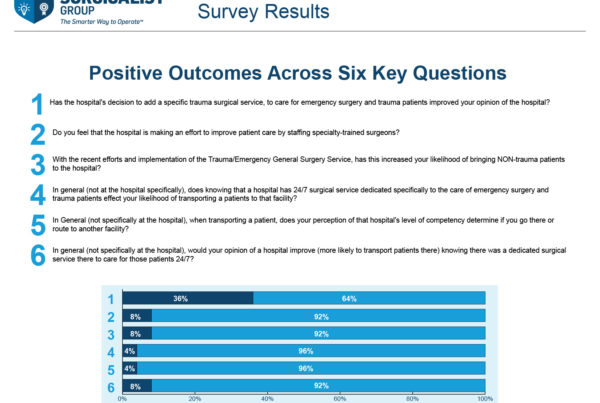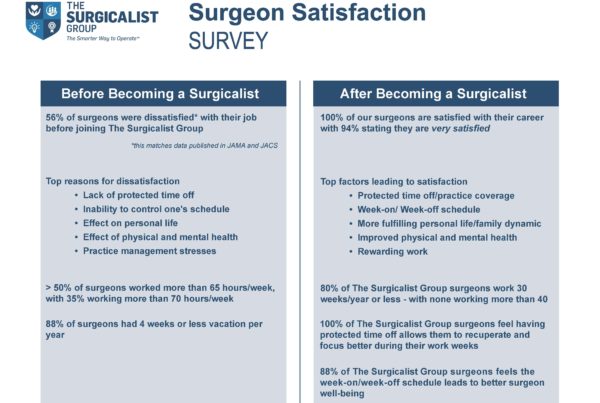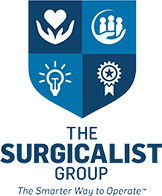Fixing one side of the equation is not enough: optimizing value across all aspects of surgical care
There are many systems within the healthcare arena designed to “cut costs”, impact future revenue, or promise back-end savings, but very few designed to improve the real time, up-front, revenue stream starting at the initial point of patient contact in the Emergency Room. To optimize the value of surgical care, The Surgicalist Group’s (TSG) model has data proving increased number of cases captured from the ED, improved clinical documentation accuracy on those encounters leading to a more accurate case mix index (CMI). Our rigorous surgeon on-boarding process focuses on optimizing patient care based on the unique needs of the hospital and improving utilization and efficiency as patients move through the facility. Also, every one of our surgeons completes clinical documentation improvement (CDI) training focusing on complete and accurate DRG capture.
Objective
We wanted to evaluate our CDI training and our model of patient care to determine if our hospital centric approach to surgical care could accomplish two things: maximize case capture by minimizing patient leakage from the emergency department (ED) and improve clinical documentation accuracy leading to upfront revenue increases for the hospital.
Findings
Our model, when compared to traditional surgical staffing, has shown up a 130% increase in operative surgical case capture from the ED. When specifically looking at index cholecystectomies, we have seen increases as high as 169%. This improved operative volume, along with our, previously proven, LOS reduction showed a net positive on all sides of the equation: more patients admitted, more surgeries performed (all with improved accuracy of clinical documentation), and an increased in-hospital efficiency.1,2
One of the biggest top line impacts for the hospital comes from the improved clinical documentation surgicalist provide on all patients encountered. Better documentation of appropriate DRG’s and more thorough clinical charting leads to a more accurate surgical CMI for the hospital. At one of our hospital partners, the year prior to the institution of the surgicalist program and the acute care surgical service CMI was 2.64. The next year, when The Surgicalist Group was covering ~30% of the call days, the CMI was 2.74, over the next year The Surgicalist Group moved to taking about 50% of the call and the CMI moved to 2.8, the following year 70% of the call days with a CMI of 2.84 and finally after covering >80% of the call days, the CMI was 2.95. We would expect the trend to continue if The Surgicalist Group was taking 100% of the call and removing the less thorough documentation of the non-The Surgicalist Group surgeons. Assuming approximately $4,500 for every 0.1 CMI improvement, this documentation accuracy and DRG capture lead to substantial revenue capture for the hospital.
Discussion
Establishing a surgical service, solely dedicated to the hospital and the needs of its patients, provides several benefits over the traditional model of staffing with community surgeons taking ED call.3,4 Surgicalists can offer unencumbered support to all areas of the hospital, rapid assessment and disposition of consults, and better OR utilization, by being available to fill unexpected operating room openings, are just a few specific advantages. While evaluating our data, some of the improved metrics we observed with the surgicalist model were directly measurable. Some information we gathered from interviews with ED providers and administrative staff. Obtaining the improved case capture data was a straightforward comparison of the urgent and emergent cases done, per call day, prior to The Surgicalist Group being contracted and comparing it to how many cases being done after the hospital’s transition to a surgicalist model. The Surgicalist Group had a 130% increase in cases performed per call day compared to the baseline set with the traditional call model. With many publications looking specifically at the medico-economic burden of acute cholecystitis we wanted to analyze this patient population separately to evaluate our results compared to the published data.
Multiple studies have shown acute cholecystitis and biliary cholic are very expensive pathologies to treat, often due to the inadequate surgical attention paid to the disease during the patient’s index visit to the ED.5,6 Traditionally patients who were able to be “cooled down” with antiemetics and pain control were sent home to follow up with the ‘on-call surgeon’ and be scheduled for further workup or an elective cholecystectomy. We interviewed the ED physicians and discovered that extreme measures were being taken to get the symptoms of patients, with obvious cholecystitis, controlled enough to be sent home, avoiding surgery at all costs. Some ED physicians reported needing to give multiple doses of IV narcotics and anti-nausea medication over several hours in order to “get them out the door”. These cool-down measures were being performed even in patients with definitive operative signs.
From the literature we know that up to 27% of patients who present to the ED with signs of biliary cholic or cholecystitis and managed without an operation will have a least 1 recurrent attack prior to their elective operation. These patients are often dissatisfied by their lack of definitive treatment at the initial hospital where they sought treatment and tend to follow up at other institutions. 7,8 We surveyed over 50 cholecystectomy patients cared for by The Surgicalist Group. We found that 32% of them had more than 1 visit to the ED for biliary issues and 16% had 3 or more visits before receiving surgery despite presenting with classic symptoms and laboratory findings of cholecystitis at their index visit. These multiple visits not only lead to high patient dissatisfaction, but also lead to higher surgical complication rates, especially in elderly patients.9 Establishing a surgicalist service, where the focus is strictly on in-patient care, allows for rapid and appropriate care being provided during a patient’s first encounter with the hospital. We found that before The Surgicalist Group took over the acute care surgical service, many cholecystitis patients were being admitted to the medical service which lead to delayed trips to the OR and delays in discharge adding to increased LOS. The delay of one day, taking a patient with acute cholecystitis to the operating room, adds a 22% to the cost of admission.10,11 At hospitals we have partnered with, all surgical patients get admitted to The Surgicalist Group’s service showing not only improved outcomes, but also improved throughput.
We followed strict criteria in determining which patients with RUQ pain were deemed appropriate for expedited operations rather than being deferred for further workup or elective operations. Patients with a classic history of cholecystitis or biliary cholic and the following criteria: intractable pain or nausea (requiring more than 2 doses of IV medication for control), ultrasound evidence of stones, sludge, or gallbladder wall thickening, a stone in the neck of the gallbladder, elevated white blood cell count, signs of SIRS or sepsis, two or more attacks within the last year, and/or multiple ED visits for the same issue, were deemed urgent operative candidates.
It was difficult to assess why, under the non-surgicalist model, patients with definitive signs and symptoms of cholecystitis or symptomatic biliary cholic, were being discharged rather than receiving an appropriate operation. We interviewed the ED providers and asked what rational was being given, by the on-call surgeon, as to why urgent surgery was not being offered as the treatment option. The common, paraphrased, responses were, ‘I have clinic today, it will be easier for them to follow up here’, or, ‘I won’t be able to get over there until late tonight, have them follow up in my office’. Most responses centered around the on-call surgeon not being truly, 100% available to the hospital except for dire emergencies. These on-call surgeons were all receiving a stipend, from the hospital, for committing to ED surgical coverage.
After we established the surgicalist service it took several months to change the emergency room physicians engrained way of thinking. We would discover patients, with justified surgical issues, sent to our clinic rather than having received a consult while the patient was in the emergency department. When we would inquire as to why we were not called at the patient’s index presentation, the ED providers stated, they were so accustomed to being ‘shot down’ on a surgical admission, they had given up trying – leading to a huge amount of lost revenue for the hospital. As we educated our ED colleagues on The Surgicalist Group approach, compared with the community surgeons, and made our intentions of being team players known, the surgical service volume immediately increased.
Conclusion
It is impossible to focus 100% on one’s private practice and provide undistracted coverage to the hospital; the two are mutually exclusive. Today we live in a world with a much faster pace than ever before. Emergency departments are busier, they are the gateway to the hospital, wait times are expected to be less, and traditional coverage models leave serious gaps in patient care. The surgicalist approach has proven better for outcomes, is more desirable for EMS and ED providers, improves hospital revenue and case capture, decreases complications, and is highly desirable for patients. Surveyed patients were much more satisfied with the expedited treatment under the surgicalist approach. When asked, 93% of patients preferred the more rapid treatment of same day surgery to the traditional surgeon on-call model. Patients reported the surgicalist approach was far more convenient with 87% stating the model was more “focused on the patient rather than the surgeon”. 93% of cholecystectomy patients were either satisfied or very satisfied with treatment and 85% stated they were likely or very likely to recommend treatment by a surgicalist over a traditional surgeon to their friends and family. We found patients were not always aware of the risk of additional attacks and complications if their surgery was delayed under the classic approach. After patients were counseled regarding the fact, they have a 20-30% risk of another gallbladder attack before receiving their surgery, 18% of patients who favored the traditional treatment model changed their mind in favor of the surgicalist model.
In the 1990’s, Internists realized having both an in-patient and out-patient practice was untenable for their personal lives, bad for patient care, demonstrated worse metrics, and was detrimental to hospital financials. The advent of the Hospitalist service revolutionized hospital efficiencies, revenue generation, and patient outcomes. Three decades later it is time to see the same opportunities for surgical services. Paying community surgeons to provide surgical coverage is not the same as getting a dedicated and focused surgicalist service to provide acute care surgery. Increased patient capture, better documentation with improved CMI accuracy, higher revenue, fewer complications, and improved patient satisfaction are all proven benefits to the surgicalist model. It is becoming harder and harder to argue with change when all the data seem to point The Surgicalist Group as the smarter way to operate.
A White Paper written by: Casey Thomas DO, David Terry DO, Jay Saxena, Bruce Curran, Mit Desai, MD
Download the complete white paper.
References:
- The Surgicalist Method: Better Workflow, Better Care, Better Bottom Line. Becker’s Hospital Review, 2015
- Oliver Wyman Healthcare Cost and Utilization Project, 2016, Performed for The Surgicalist Group
- O’Mara M, Sherer L, Wisner D. Sustainability and Success of the Acute Care Surgery Model in the Non-Trauma Setting, JACS.2014;219(1):739-44.
- On-Call Crisis: A Statewide Assessment of the Cost of Providing On-Call Specialist Coverage, Ann Emergency Med.2007;49(6):227-233
- To K, Kamdar N, et al. Acute Care Surgery Model and Outcomes in Emergency General Surgery, JACS, 2018;07(664):21-8
- Pushwaz W, Paranjape C. Variation in National DRG Payments for Laparoscopic Cholecystectomy: Hospital Level Analysis, SAGES, www.sages.com
- Macedo F, Eid J, et al, Impact of medical or surgical admission on outcomes of patients with acute cholecystitis, HBP, 2017;19:99-103
- Schwartx D, Shah A, et al, Operative delay to laparoscopic cholecystectomy: Racking up the cost of healthcare, J Trauma Acute Care Surg, 2015;79(1):15-21
- Riall T, Zhang D, et al, Failure to Perform Cholecystectomy for Acute Cholecystitis in Elderly Patients is associated with Increased Morbidity, Mortality, and Cost, J AM Coll Surg, 2010;210(5):668-79
- Wadhwa V, Jobanputra Y, et al, Nationwide trends of hospital admissions for acute cholecystitis in the United States, Gastroenterology Report, 2017;5(1):36-42
- Ellison, A. Average Cost per Inpatient Day Across 50 States. American College of Surgeons Communication, 2018





